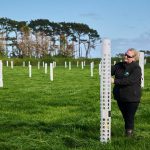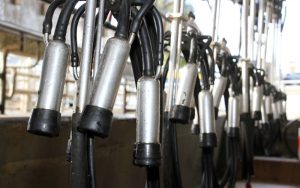
The cows are bringing home the milk for Canterbury farmers ahead of South Island collections rising overall by about 5% over early spring.
Fonterra received just under 70 million kilograms of milksolids from South Island farms in September.
The giant co-op credited the increase mainly to favourable weather supporting pasture growth in many regions with some areas at that stage on surplus moisture levels. This was partially offset by storms impacting production in the lower south.
In the North Island, Fonterra’s milk collections for the month were ahead by 4.8% and good weather again shone on farmers.
Federated Farmers Mid Canterbury Dairy chairman Nick Giera said the district’s strong milk production had carried through into this month.
“Canterbury would probably be up slightly more than 5% and from what I understand Canterbury is up more like 7%, but Southland and Otago are likely to be back so the overall 5% sounds right to me. Cows are still producing ahead of last year and the grass quality is still very good and that means they are producing well.”
Mr Giera contract milks 1400 cows at Ruapuna.
“We are up 8% on last year. Last year was an OK season and probably in spring we were slightly behind than we normally are. We are probably in line with the regional average in being slightly ahead of normal. It will help as Mid Canterbury tends to have very stable production and doesn’t fluctuate as much as other regions because of the ability to grow pretty consistent levels of feed each year.”
He said the main factor helping cashflows was a forecasted higher payout.
“At the moment Fonterra has lifted their forecast between $9 and $10 (a kilogram of milksolids) with a mid point of $9.50 so that will help with the top line and interest rates will ease slightly with the OCR dropping. But we are not really seeing any easing on costs so everything has just lifted over the last five years.”
Mr Giera said cashflows would be better after a break-even season last year.

Many small businesses relied on dairy farmers spending money and most of them would be able to get maintenance back on track and catch up on any work which had been deferred.
“The season in Mid Canterbury is going very well so far. We’ve had kind weather through the spring and good calving and now we’re into mating the weather has been good for most dairy farmers. We’ve had good grass growth and plenty of sunshine which is good for mating.”
He said most parts of Canterbury caught the welcome rain over a stormy Labour weekend; the farm he was based at collected 110ml.
Rain landed without the snow, unlike parts of Otago and Southland dealing with rougher weather.
“We’ve had a lot of nor’wests which tends to mean rain in Southland and Otago. We’ve had a good one, but I know there are plenty of other farmers which haven’t had such good seasons so far.”
Most irrigators had started again since the October storm as the weather shifts to a nor’west pattern with grass growth going “flat out” and needing water.
Farmers were keeping up with irrigation and a lot of silage was being made in the district.
He said supplementary feed levels were a good sign for later in the season and winter.
“A review of some of the regulations proposed under the previous government plus better farmgate returns are definitely helping to lift confidence in the dairy industry. It would be nice to have the same level of confidence in the sheep and beef industry as those guys are struggling.”
Rabobank senior agriculture analyst Emma Higgins said in an agribusiness monthly report that Australian milk production was up in a strong start to the season by 1.4% for September.
Northern hemisphere milk flows were a mixed bag. The United States was marginally up for the month, although an outbreak of avian influenza in California last month could peg this back and the European Union was back 1.4% in August. China was in a slowdown after several years of strong growth.
This scenario helped to spur Fonterra last week into lifting this season’s milk price forecast from a midpoint of $9/kg to $9.50/kg. The new range of $9/kg to $10/kg was also based on more of its sales lined up in contracts than the previous update in September.
Chief executive Miles Hurrell said the improved outlook had largely been driven by strong demand for commodity products, which had helped to push prices up in recent Global Dairy Trade auctions.
“This demand has been seen out of China, where there are indications that domestic production is below expectations, and also in Africa, the Middle East and Southeast Asia.
“Looking ahead, we’ll closely monitor any factors that could have an impact on supply and demand. This would include any significant change to milk supply in New Zealand over the second part of the season which could lead to pressure on global milk prices.”
He said the co-op would continue to put more milk into higher returning products to capture more value.
You can now read the most important #news on #eDairyNews #Whatsapp channels!!!
🇺🇸 eDairy News INGLÊS: https://whatsapp.com/channel/0029VaKsjzGDTkJyIN6hcP1K

























